we r now[here] by Helen Varley Jamieson
Cyberformance Critique
As the final assignment in our performance of “we r now[here] by Helen Varley Jamieson, each of you will write a Cyberformance Critique, due Monday, April 20th. I want you to first review the performance documentation. Then synthesize the entire process of how we collectively created, rehearsed, discussed, and performed the work. Consider the Mobile Cam exercises as part of this process. What I am looking for is how did the overall process, not just the final outcome, demonstrate the topics of this course.
We have discussed the many implications of the Webcam as a lens that collapses space. We have talked about the third space as a networked environment for bringing people together locally and remotely. You have all created collective projects (The Collective Body in Flickr and The Telematic Embrace exercise in Adobe Connect) that explore social relations on the Internet. We have reviewed third space, collective artworks by historical artists (such as Hole in Space, by Kit Galloway & Sherrie Rabinowitz or Paul Sermon’s Telematic Dreaming) to show the creative use of the Internet as an artistic medium. We have discussed how the Webcam can be used for live broadcasting such as in Jennicam. We discussed The Big Kiss by Annie Abrahams, exploring the intimacy of the telematic connection. And you have read the writing of Helen Varley Jamieson in which she discussed previous cyberformance projects such as “Make-Shift” that brought people together in creative dialogue via Webconferencing. Of course we have also discussed many other projects by additional artists as well and you can incorporate them into your assignment. You don’t need to discuss every piece, just the ones you think are useful to support your critique.
As you can see, our performance was intended to be a culmination of all that we have studied this semester and I want you all to consider what we have discussed to write a 500 word Hyperessay that distills your experience in “w r now[here],” with statements and observations supported by the readings and artworks we have explored together in class. Incorporate a few screenshots from the video in key locations by opening it full screen. You can also incorporate screenshots from your Mobile Cam exercises that help to illustrate your points. I recommend that you provide references from the readings and be sure you cite where it came from, the author, etc. Be sure and look at your research critiques for relevant references, you don’t have to reread everything. I emphasize this because I want you to do more than describe what happened, but explain how each step of the process helped you to understand what we have covered in Media & Performance. Again, be sure you watch the documentation video before you write your hyperessay. I would also suggest reviewing the entirety of this project page.
We will discuss the performance in class on Wednesday, April 8 to help you frame your Cyberformance Critique hyperessay, which is due on Monday, April 20th.
w r now[here] by Helen Varley Jamieson
Cyberperformance artist Helen Varley Jamieson is creating a new work specifically for the Media & Performance students, which will be performed on opening night of the Art of the Networked Practice | Online Symposium (Tuesday, March 31, 7:30 pm). The work will be performed via Adobe Connect and broadcast to the Main Lobby & Library Screening Room at ADM, as well as over the Web to an online audience. Helen will direct the project from her studio in Munich, Germany. This is an unusual opportunity to work with one of the renowned performance artists who engages networked space as her medium, which she refers to as “Cyberformance.”
Date: March 31, 2015
Preparation: 7:00 pm – 7:30 pm via Adobe Connect (with Helen)
Performance: 7:30 pm – 8:00 pm via Adobe Connect
we r now[here] is a cyberformance about nowhere and somewhere: the “nowhere” of the Internet becomes “now” and “here” through our virtual presence. Approaching the virtual somewhere from a physical nowhere, we glimpse streets, public transport, corridors, doorways – physical representation of data packets and pixels on the move – until the audio-visual streams converge into a single “now-here” in the somewhere of the Internet.
Student performers: Huang Pei-Sheng (Frank), Quek Ming Jie (MJ), Ruzana Abdul Rahim, Tao Sheng (Tommy), Beverley Ng, Hannah Lerner, Mercik Bridget Tyler, Prakash Perumal Haridas, Eugene Soh, Ashley, Sharanya Pillai Lai, Diana Toh
Final Performance Instructions
Preparation:
Everyone is ready at 7:00pm SGT
- Onsite performers: be logged in to the WIRELESS NETWORK and Adobe Connect by 7pm in the ADM lobby
- Offsite performers: be logged in to Adobe Connect by 7pm and set your chat text colour to something other than black and change your name.
- Everyone: fully charge your mobile!
- Everyone: wear earbuds or headphones
Approx. 7.20pm: Announcement Cue (to your places)
Randall announces the performance as our starting cue and invites the audience to go to the theatre. Take note of the exact time on your phone! Once Randall begins, follow the clock on your phone and calculate all times from this starting point.
- Onsite students: go to your starting place in the building
- Offsite students: start interacting in the chat with the online audience.
Part I: The Journey @ ADM
Approx. 7:30pm (or 10 minutes after Announcement Cue)
The performance begins. Remember: we do not want to see your own image until the “selfies” at the very end!
Onsite students:
- Start streaming a still image for 20-30 seconds
- Make your journey from your starting point to the lobby; take your time, this should take 10 minutes including the still image shot
- Go slowly and pause on close-up shots. Stay on a close-up for 10-20 seconds then move slowly on.
- DO NOT SHOW YOURSELF.
- Don’t get distracted by passing friends, just ignore them and focus on your task.
Offsite students:
- Your task is to provoke and engage the online audience, so that we have textual input from them that relates to our theme.
- Ask the audience questions like: - where are you going? - where have you come from? - what have you left behind? - where have you been? - where are you not?
- You can also use text from Piratepad.
- Add audio – if you have an external mic, put it close to your keyboard for the sound of your typing, & any other sounds you can easily make such as creaks, rustling, machinery, etc. Don’t show your webcam, just have the audio on.
Part II: The Lobby @ ADM
Approx. 7:40pm (or 20 minutes after Announcement Cue)
Onsite students:
- Arrive at the lobby and explore the lobby with your camera, showing us the scene of an abandoned party – use close-ups such as abandoned glasses and remnants of food; pause for 10-20 seconds on a close-up then move on.
- It’s ok for two people to show a close-up of the same object at the same time, from different angles, as long as you aren’t showing each other.
- AVOID SHOWING EACH OTHER OR YOURSELF
- After you’ve explored the space for a few minutes, start to show the audience who are still in the lobby; show us their shoes, hands, what they are holding, handbags, etc.
- Gradually show the whole person.
- Avoid showing your fellow student performers.
- Kathryn arrives meet the students in the lobby and to indicate the number of places left in the theatre.
- On Kathryn’s cue for the number of empty seats, start to bring people from the lobby to the theatre. Speak to them if you have to, but use gestures and work together to “herd” them. Guide them by showing them on their journey to the theater with your cameras.
- AVOID SHOWING EACH OTHER OR YOURSELF
- Wei Long turns on the overhead cam
Offsite students:
- Helen & offsite students continue with texts, responding to what’s happening in the cameras and encouraging online audience to contribute.
- Continue with sounds as well.
Part III: The Library Screen Room Theater
Approx: 7:50pm (or 30 minutes after Announcement Cue)
Onsite students:
- Students and remaining audience arrive at the theatre.
- With the audience seated, stand on both sides of the aisles (equal number on both sides) and capture sections of the audience on your cams to make one large jigsaw/collage of the audience.
- Remember the theater might be crowded so be careful to cross over the front or the rear of the audience.
- DO NOT STAND IN FRONT OF THE SCREEN
- Hold the image for 10 seconds, then swap places with the person next you and make a new composite image.
- Be sure you check the screen for the next big cue
Offsite students:
- Ask questions again, this time using “we”: – where are we now? - where have we come from? - what have we left behind? - where have we been? – where are we not?
- “we r now[here]” will appear on the screen (Helen will do this).
Onsite students:
- CUE: When YOU SEE “we r now[here]” APPEAR ON THE SCREEN, lift your camera up and back up to show a wide shot of the audience.
- Then, still keeping your cameras on the audience for as long as possible, leave the theatre space and go outside to the “circle area.”
- Outside the theater form a circle and turn your camera around to make a selfie; HEAD AND SHOULDERS SHOT, STILL CAMERA, FOR 5 SECONDS.
- Pass cameras around to appear in different windows in Adobe Connect. Count to 5 with each head & shoulders still shot. Kathryn will help to cue/direct this part.
- When you are done, come back into the theatre, stand in formation in front of the screen and take a bow
- Hand your mobiles to the front row audience so that they can film you taking your bows.
- Helen will play closing music in Adobe Connect
Offsite students:
- When the onsite students students show their selfies, bring on your camera to show your selfie as well.
- When they are passing their cameras around you can move around or improvise in response to what they are doing. When they take a bow you can also take a bow.
- Helen will play closing music in Adobe Connect
THE END
Approx 8:00pm (or 40 minutes after Announcement Cue)
Randall will signal the end of the performance when he makes an announcement to the local and remote audiences that the evening is over and to come back the next day for the panels and keynotes.
Instructions for using Adobe Connect Mobile
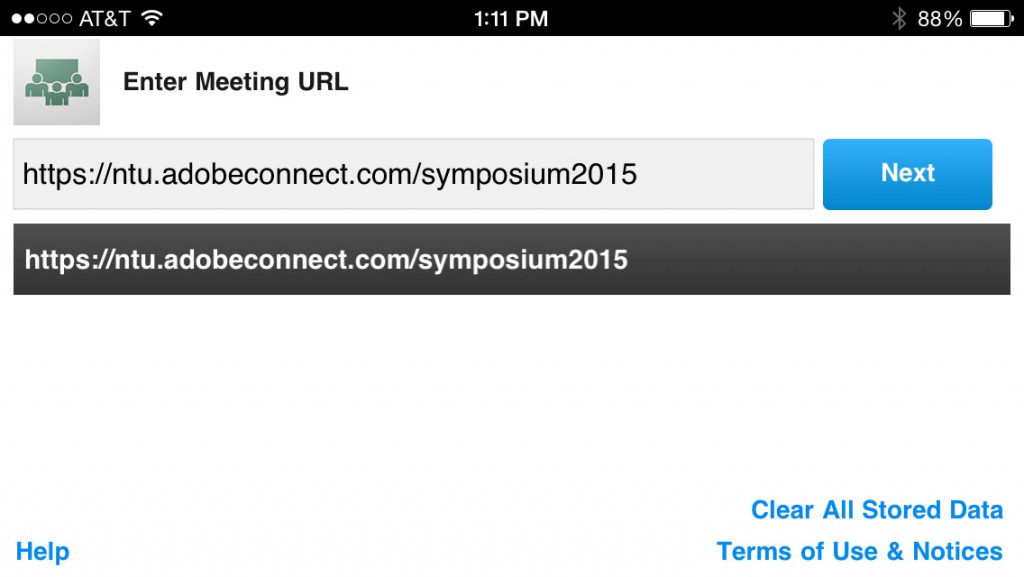
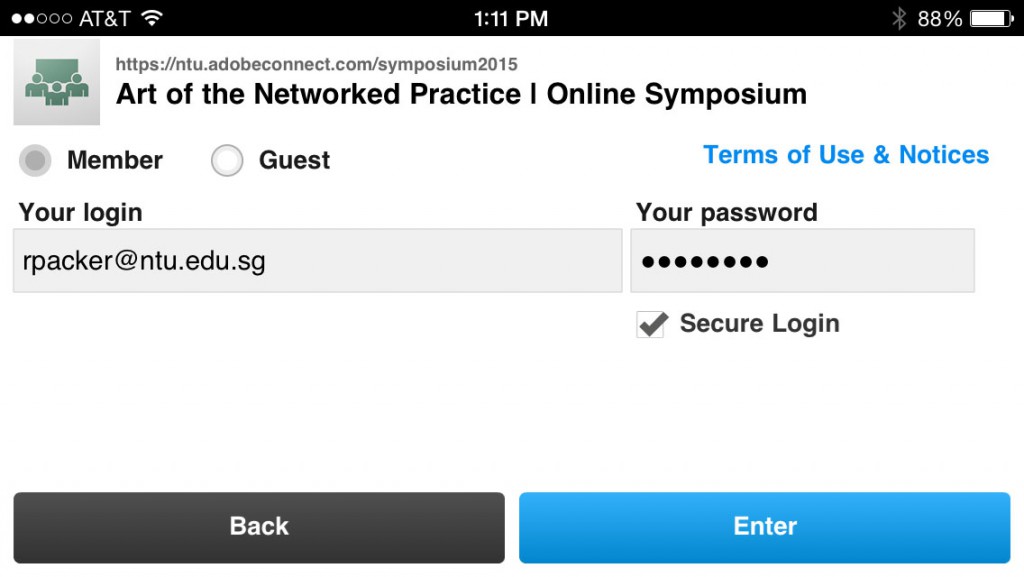
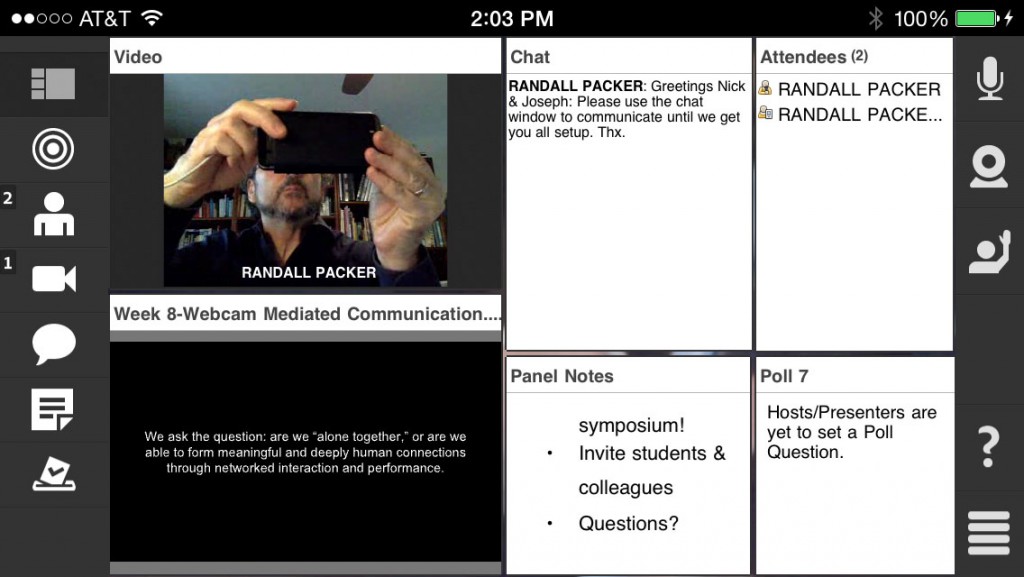
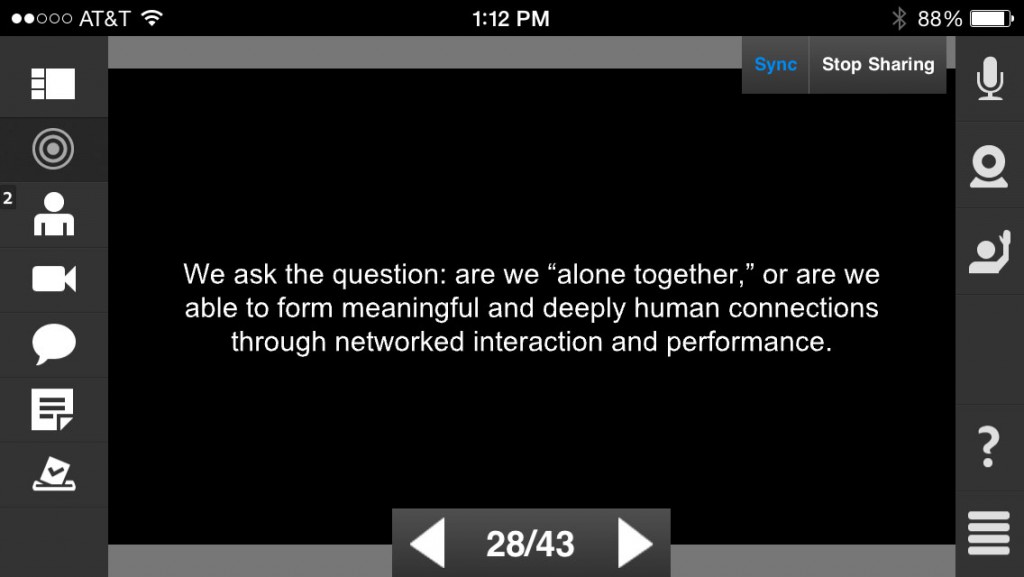
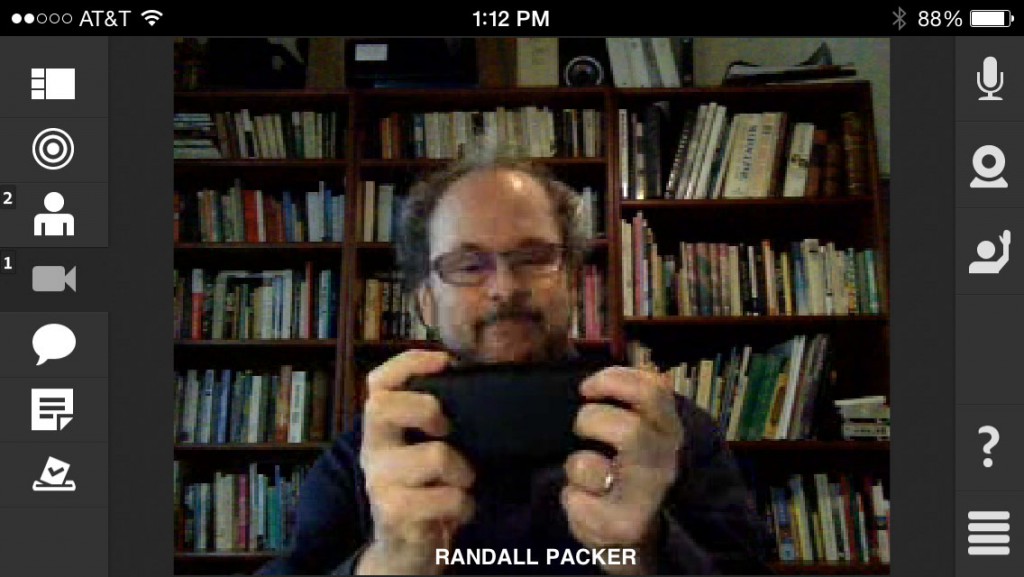
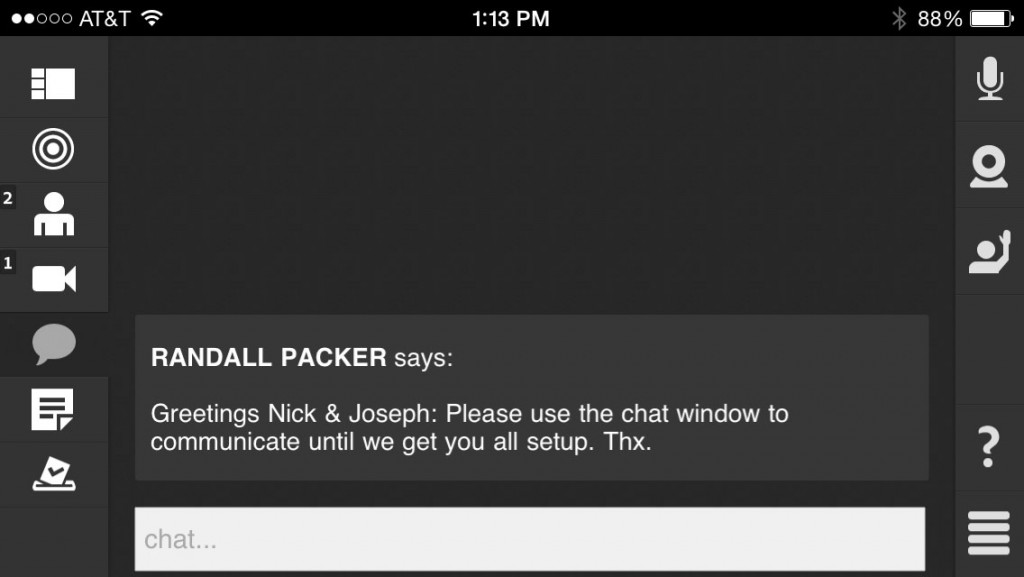
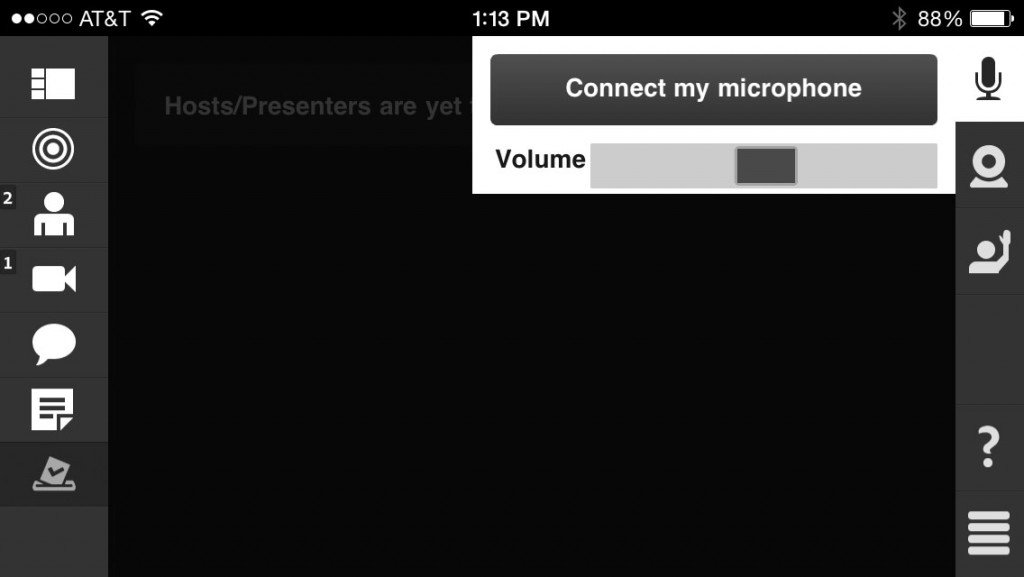
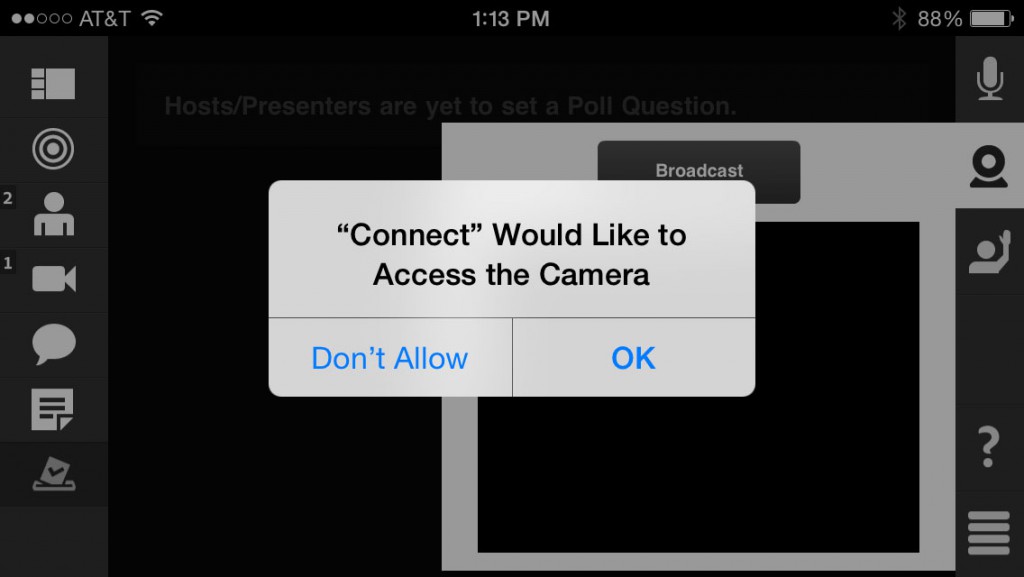
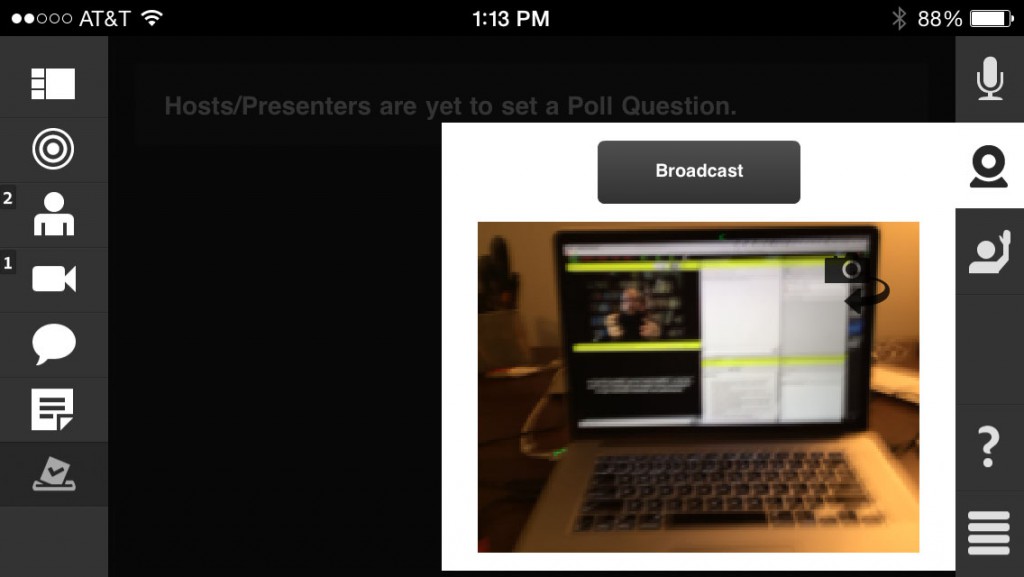
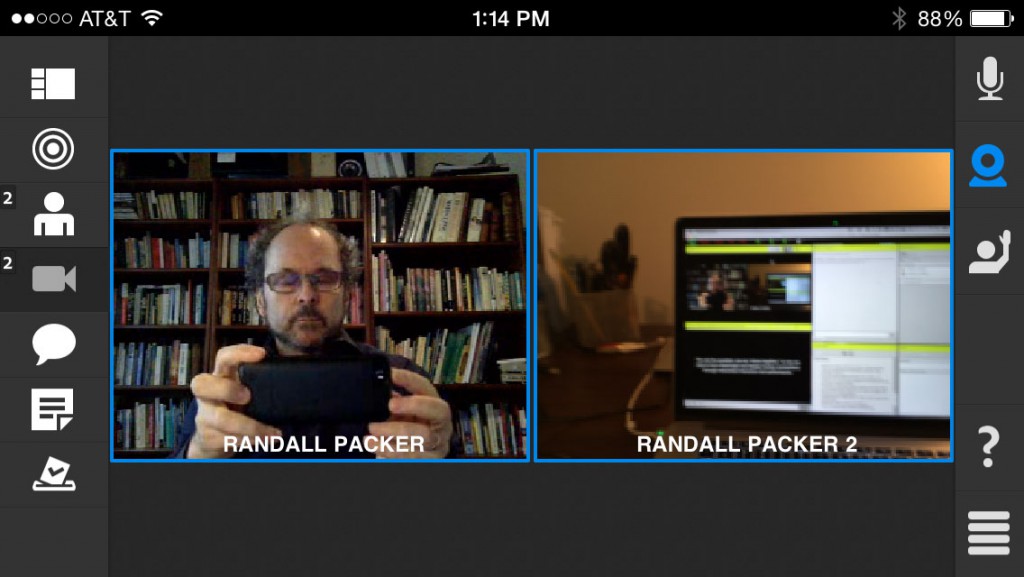
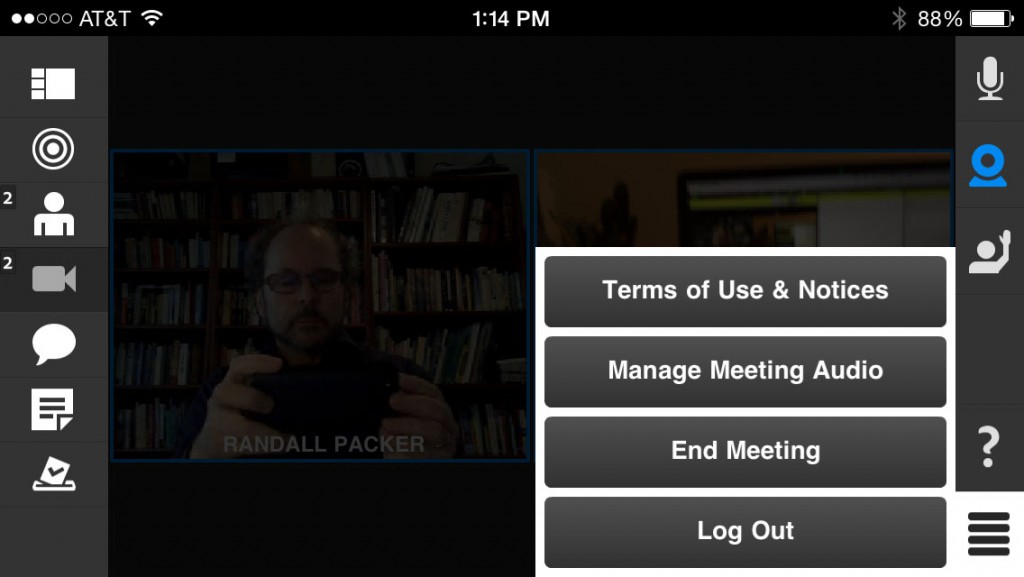
If you have any additional questions, click on the ? icon on the right side for help.
Helen Varley Jamieson
Helen Varley Jamieson is a writer, theatre practitioner and digital artist from New Zealand, currently based in Munich, Germany. She completed a Master of Arts (Research) at Queensland University of Technology (Australia) in 2008, investigating her practice of cyberformance (live performance on the internet), and works as an independent artist and researcher. Helen is one of the founders of UpStage, an artist-led open source online platform for cyberformance, and has collaborated in the organisation of six online festivals of cyberformance using UpStage (2007-12). In 2012 she was one of the organisers of the CyPosium, a one-day online symposium about cyberformance and networked performance, after which she co-edited with Annie Abrahams CyPosium – the book, published in 2014 by Link Editions.